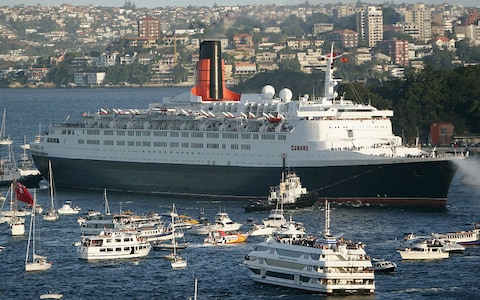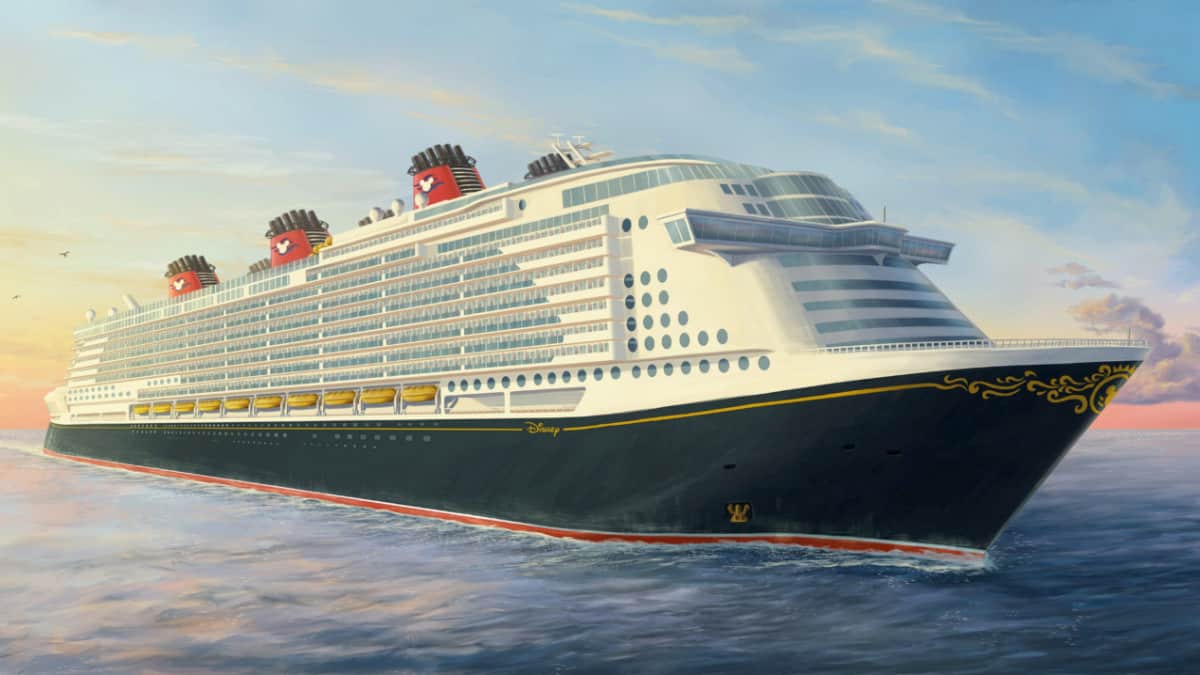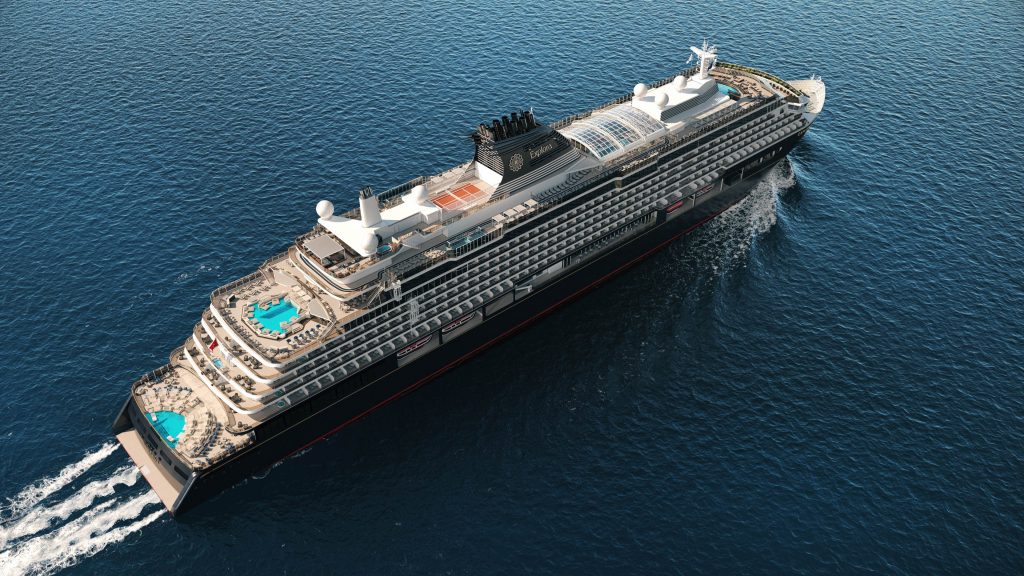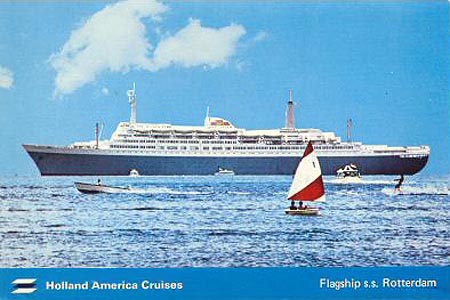At the end of their careers, both Queens, the Elizabeth and the Mary, were rapidly losing money. The jet airliner had obviously won the battle, and in 1966, almost all transatlantic travellers had deserted the liners…….
Plans for a successor of both Queens, known as the Q3-project were short lived. Q3 would have been a transatlantic liner again, and although ship owners were reluctantly to surrender to air travel, it all became clear as they saw passenger loads dwindle.
So Cunard abandoned the Q3 plans, although several yards had already drawn up quotes, and reconsidered: the new ship had to be suited for cruising as well.
Obviously aware of the problems they had encountered when sending the old Queens on cruise service (no airconditioning, no pools, 3 classes with very different accommodations, impractical lay-out etc.), the new plans (code name Q4) comprised both liner and cruising elements.

Q4 would make several transatlantic crossings each year, but would serve most time of the year (appr. 8 months) as a cruise ship. Instead of the usual three classes, there would only be two, and both would have about the same level of luxury and facilities, thus enabling Cunard to amalgamate these classes to one-class for cruising. Apart from using separate restaurants, there would only be minor differences between both classes when in liner service.
Although the same service speed was needed as the former Quens, 28.5 knots, the QE2 was designed so that 110.000SHP would suffice, against 160.000SHP of the Mary and the Elizabeth. QE2 was also downsized to one boiler room instead of two on her predecessors, saving 50% on fuel consumption.
Her shorter hull and less draught made it possible for her to enter ports in cruise service the old Queens couldn’t.
John Brown and Co. at Clydebank built the Q4, on the same slipway the Queen Mary had come into existence.
Of course there were plenty of rumours about the name of the new vessel, but not before her launching would it be known that this would be Queen Elizabeth 2, often shortened to QE2.

Building started in June 1965, and two years later, she was launched by Her Majesty the Queen Elizabeth II, on September 20th 1967. She used the same pair of golden scissors that had been used when launching the previous Queens.
QE2 received just one funnel, but a remarkable one, the result of much testing and remodeling. It was painted all white, the windscoop in Cunard-red.
November 1968, QE2 ran her sea trials which were not very successful. Serious turbine problems made her return for immediate repairs at John Brown’s. After problems were rectified, Cunard still refused to accept delivery of the QE2 because of many other problems that had emerged during sea trials and which had to be addressed to first. Cunard even had to cancel her maiden voyage for which she was fully booked.
But at last, in May 1969, QE2 started her career on the high seas.

Many feared that QE2‘s liner service would end prematurely as in the early ’70s, such ships as the United States and France were taken out of service, having lost the battle with the jet airliner.
However, QE2 survived, and continued making her transatlantic voyages between Southampton and New York. But her (world-)cruises have made her famous. Indeed she is the most publicized and well known passenger ship of the last 30 years.
During her early career, in 1971 she rescued 500 passengers from the burning French passenger liner Antilles. A year later, she received a bomb threat, but after thorough investigations of her crew and a special forces team that had been parachuted in, it turned out to be a hoax. In 1973 she was chartered for two cruises to Israel which celebrated its 25th year of being a state. Special security measures were taken. In 1976 QE2 suffered from a fire in the starboard engine as a result from a ruptured flexible coupling and oil spraying into the engine where it ignited. The fire was controlled very quickly, but resulted in one of her boilers needed to be replaced, for which a hole had to be cut in her side.

No one ever thought it would happen, but in 1982, the QE2 was seized by the English government for war duties as a troopship in the Falkland war. These islands had been invaded by Argentina, having claimed these islands for years. England didn’t want to give up the Falklands, and sent a fleet of (war)ships to the area. QE2 and P&O’s Canberra acted as troopships. Canberra did the dangerous work, as the British did not want to endanger their national pride, the QE2. She was sent to South Georgia, located over 2000 km’s from the danger zone. Canberra would ferry QE2‘s troops to the war zone. QE2‘s radar was shut down and she was blacked out, so she could not be detected at sea.
Queen Elizabeth 2 and Canberra received a heroic welcome upon their return to the UK.
The Queen was refitted and her funnel colours were now switched to the original Cunard livery of black and red.
Nothing much happened the following years, and QE2 divided her time between liner service on the North Atlantic and cruising.

However, by now her engines, her turbines to be exact, would gradually become more and more troublesome. Cunard needed her to be at sea as much time as possible, as one day in port cost them around 100,000$. This meant that her boilers were almost always in operation and maintenance work had to be carried out at sea, which from maintenance perspective wasn’t the best situation. Apart from as many sea days as possible, she needed an oocupancy rate of over 60% to start making a profit. So in 1986, QE2 was sent to Bremerhaven, to the Lloyd Werft and at a cost of $162 mio. she received new engines of the diesel electric type. Although a huge amount of money, it was still only half of what it would have cost to build a new liner. It turned out to be a great success in both speed and cost reduction, cutting her fuel consumption in half.
In 1992, QE2 ran aground off the coast of Massechussetts, and passengers had to be evacuated. Costly repairs on her keel and bow plating had to be carried out.
Two years later in 1994, she was refitted in Hamurg, Germany, the project was code named project Lifestyle, so she could compete again with her more modern competitors and would comply with the new safety regulations.
In 1995, she was hit by a rogue wave of 27 m height 200 miles off the coast of Newfoundland, caused by hurricane Louis, but she survived with minor damage.
In 1999, yet another refit followed. Cunard was now taken over by Carnival Corp. but luckily, QE2 had preserved her English charm and atmosphere in the process (some of her public rooms had been redone and the shops on board had been brought in line to those of other cruise ships), and sailed on for another decade. Three years later, she reached her 5 millionth mile, somethinh no merchant vessel had ever been known to accomplish.

In January 2004, the maiden voyage of her new fleetmate took place, the Queen Mary 2. QM2 was one of the largest and longest liners ever built and with a contract price of $ 780 mio. (!) surely the most expensive at the time.
QE2‘ s transatlantic service was taken over by the new ship, and she sailed as a full time cruise ship from that moment on.
In 2007, Cunard took delivery of the new Queen Victoria, and it was rumoured that she would be replaced by this new vessel. And indeed, in June 2007, in a surprise move, Cunard announced it had sold the QE2 to Dubai owners who had plans to operate her as a floating hotel and museum. Her interiors will be restored to their original former glory during a refit. She will be berthed at a specially constructed pier at the Palm Jumeirah Island which is the smallest of the three Palm Islands, proclaimed by Dubai to be the eighth wonder of the world. QE2 will be handed over in November 2008 and will celebrate her 40th birthday in 2009, the year she will start her new life in the Middle East

Some interior photographs of QE2












